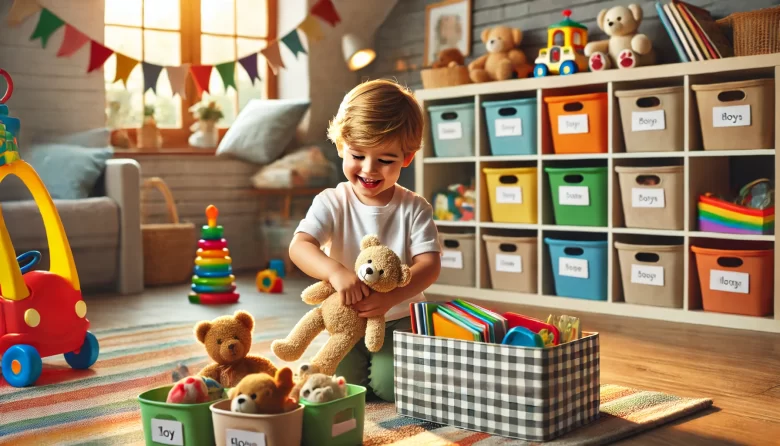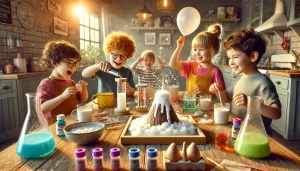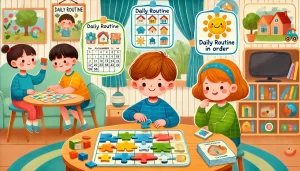Teaching young children to organize their toys and materials is an essential skill that benefits them throughout life. It helps them develop responsibility, independence, and problem-solving abilities while also keeping your home neat and stress-free. However, teaching organization to young kids requires creativity, patience, and consistency. In this guide, we’ll explore effective strategies, fun activities, and useful tips to help your child learn to tidy up in a way that feels engaging and rewarding.
Why Organization is Important for Young Children
Before diving into the “how,” let’s understand why organization matters:
- Develops Responsibility – Children learn that they are responsible for their belongings.
- Encourages Independence – Kids gain confidence in taking care of their own space.
- Reduces Stress – A clutter-free space helps children feel more relaxed and focused.
- Improves Problem-Solving – Organizing involves sorting, decision-making, and planning.
- Makes Playtime More Enjoyable – When toys are easy to find, playtime becomes more fun.
Now, let’s explore step-by-step strategies to teach young children how to organize effectively.
Start with Simple Expectations
Children thrive with clear and achievable goals. Instead of saying, “Clean your room,” which might feel overwhelming, break the task into smaller steps:
✅ “Let’s put all the stuffed animals in this basket.”
✅ “Can you gather all the books and put them on the shelf?”
✅ “Find all the blue toys and put them in this box!”
Keeping tasks simple helps young children stay motivated and understand what is expected.
Use Kid-Friendly Storage Solutions
To make organizing easier, create a child-friendly system with:
- Low shelves – So kids can reach and put items away themselves.
- Labeled bins – Use pictures for younger children who can’t read yet.
- Color-coded containers – Assign a color for different types of toys.
- Hanging storage – Great for small items like art supplies.
A well-organized space encourages kids to participate and keeps them from feeling overwhelmed.
Make Organization Fun and Playful
Children learn best through play, so turn tidying up into a fun experience:
🎶 Sing a Cleanup Song – Create a song to sing while cleaning. Example: “Clean up, clean up, everybody do your share!”
⏳ Race Against the Clock – Set a timer and see how fast your child can pick up their toys.
🦸 Superhero Cleanup Mode – Pretend to be superheroes saving the playroom from “toy chaos!”
🎲 Sorting Games – Ask your child to group toys by color, shape, or type before putting them away.
Making it fun turns organization into a positive habit instead of a chore.
Teach by Example
Children learn by watching adults. If they see you keeping things organized, they’ll want to do the same.
✅ Narrate Your Actions – “I’m putting my books on the shelf so I can find them later.”
✅ Tidy Up Together – Make organizing a shared activity instead of an order.
✅ Show Enthusiasm – Express excitement when tidying up: “Look how nice the room looks now!”
When children see organization as part of everyday life, they are more likely to adopt it.
Create a Reward System
Positive reinforcement encourages kids to keep up with good habits. Try:
⭐ Sticker Charts – Give stickers for completing small cleaning tasks.
🎁 Surprise Rewards – Occasionally reward a well-organized space with a small treat.
📚 Special Privileges – Offer an extra bedtime story or 10 more minutes of playtime.
Rewards should focus on effort rather than perfection, so children feel encouraged rather than pressured.
Establish a Routine
Consistency is key when teaching organization. Set up a regular cleanup routine, such as:
🕒 Before Meals – “Let’s clean up before we eat.”
📚 After Playtime – “Time to put the toys back before choosing a new one.”
🌙 Before Bedtime – “Let’s tidy up so we wake up to a neat room.”
Routines make tidying up a natural and expected part of the day.
Use Stories and Books About Organization
Children love stories, and books can help teach them about organization in a fun and relatable way. Some great options include:
📖 The Berenstain Bears and the Messy Room by Stan & Jan Berenstain
📖 A Place for Everything by Sean Covey
📖 Too Many Toys by David Shannon
Reading about characters who learn to tidy up can inspire kids to do the same.
Declutter Together
Teaching organization also means helping kids understand that not every toy needs to stay forever. Make decluttering fun:
🛍️ Toy Donation Day – Let kids choose toys to donate to children in need.
📦 “Memory Box” System – Keep a small box for sentimental items while letting go of others.
🔄 Toy Rotation – Store some toys away and switch them out periodically to keep things fresh.
By involving kids in the process, they learn to value what they have and make mindful choices.
Adapt to Your Child’s Age and Personality
Every child is different. Some enjoy organizing, while others need extra motivation. Adjust your approach based on:
👶 Toddlers (1-3 years old) – Simple tasks like putting blocks in a basket.
👦 Preschoolers (3-5 years old) – Sorting by type, using labels, and following short instructions.
👧 Older Kids (5+ years old) – Taking on more responsibility and personalizing their space.
Flexibility and patience will make the learning process smoother.
Praise Effort, Not Just Results
Young children won’t always organize perfectly, and that’s okay! Encourage progress by saying:
👏 “Great job putting the toys in the bin!”
😊 “I love how you helped clean up today!”
🎉 “You worked so hard! Let’s play together now!”
Focusing on effort rather than results builds confidence and long-term habits.
Final Thoughts
Teaching young children to organize their toys and materials is a valuable life skill that benefits both them and you. By using simple instructions, playful methods, consistent routines, and positive reinforcement, you can make tidying up a fun and natural habit.
Start small, be patient, and celebrate progress. Over time, your child will learn that organizing is not just a task—it’s an enjoyable and rewarding part of daily life!




